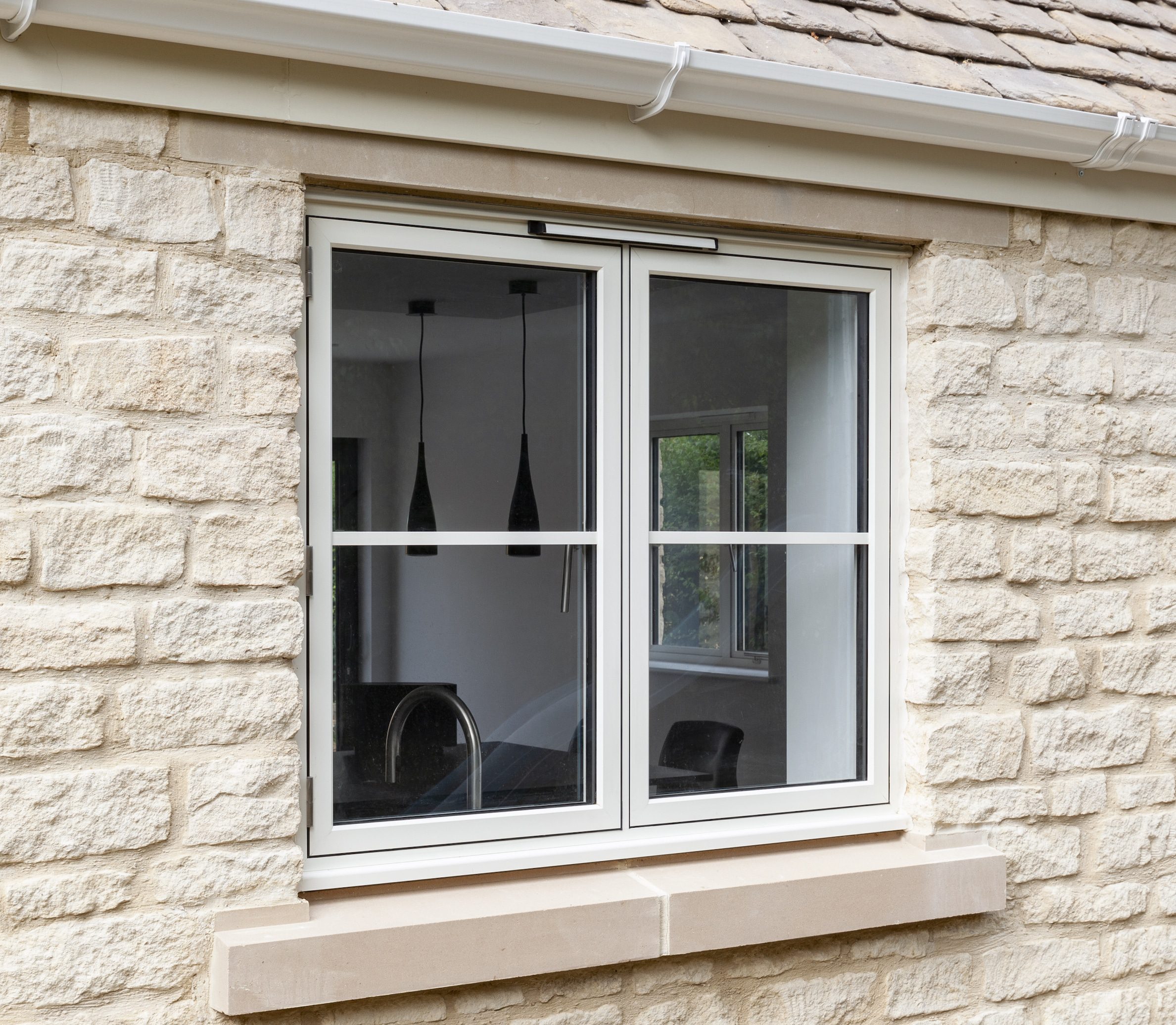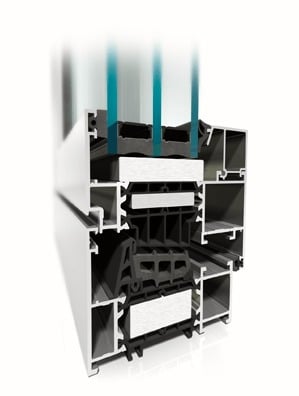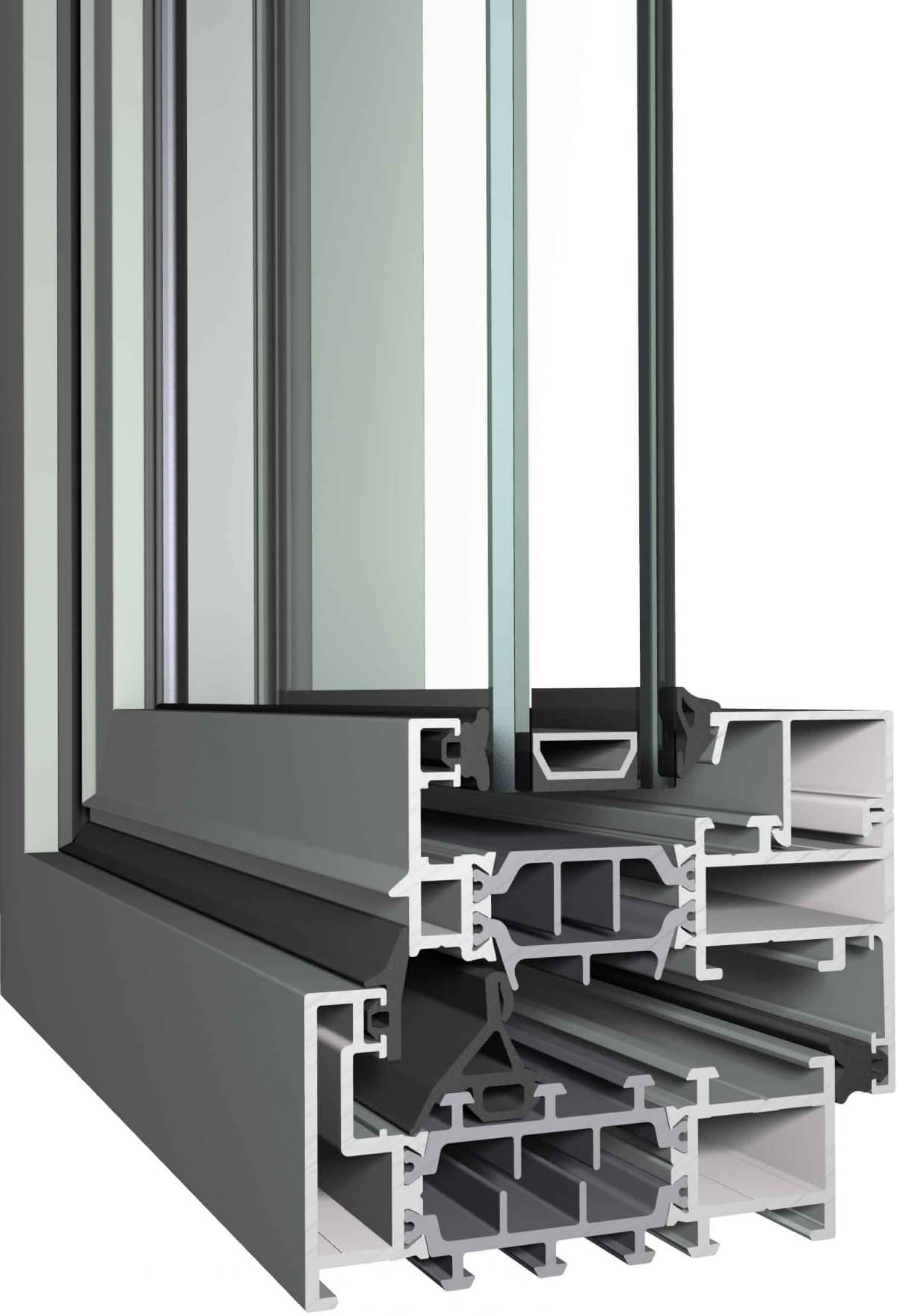Yes, externally beaded windows are safe. Whilst many windows for residential property are mostly internally beaded, there are cases where the beads have to be on the outside. This article explains more about externally beaded windows. If you’re told external beads aren’t safe, you’re not being given the correct information and here’s why.

Externally and internally beaded windows explained
Window beads are what holds the glass in place. At the same time, they’re essential when glass needs replacing, for instance, should it break.
Depending on the type of window, some of these have beads on the inside, others on the outside.
Furthermore, these window beads come in various styles to suit the window aesthetic. Window beads also come in different depths, accommodating different thicknesses of glass units.
Why you may hear externally beaded windows are not safe
Some installers say, window beads on the outside aren’t safe and are easy to remove. This is not strictly true. You may also see images online showing a break-in through a window where access is apparently quite easy by removing the external window beads.
At face value, pictures and a perception that externally beaded double glazed windows pose “dangers” to security would be alarming to any homeowner. So is this true? And given that many modern aluminium windows remain externally beaded does this carry forward that these too could be broken into easily? Here is the tweet and pictures as an example:
Why are windows externally beaded?
There are actually many valid reasons why windows continue to be externally beaded. The first is that combinations of opening vents next to fixed lights often use frames in reverse meaning the sashes are sometimes internally glazed and the fixed elements externally glazed. Many aluminium systems adopt this method. One of the key reasons why is that is helps create a much slimmer looking window.
For those wishing to have internal beads on the inside of their windows there are specific internally glazed windows available. In the case of the combination window a dummy sash can be fitted to the fixed element. This would be internally beaded but it adds to the cost of the window (as more material and fabrication time is needed) and it adds to the visible bulk.
You can read a more detailed explanation about externally and internally beaded windows. But in summary:
- Externally beaded windows provide a slimmer looking window. Some people also prefer the look of the window from the inside as there are no visible bead lines.
- Internally beaded windows make installation easy from the inside without requiring scaffolding and are the preferred option for windows fitted in tower blocks or high level generally.
Are externally beaded windows a security concern?
No. Rather than make such a general statement about externally beaded windows, it is worth considering several important points regarding window security, PVCu windows and the whole externally beaded debate. And this is not a new debate. As far back as 2011 we were writing about the security of externally beaded aluminium windows.
In factual and simple terms, an externally beaded window today is not a security risk. However it’s worth examining why it could be.
No reputable window company would knowingly sell a homeowner windows that are not secure. And in any case it is almost impossible to with today’s modern double glazed windows. Whilst we don’t possess the facts about how this specific PVCu window was broken into, we can explain the situations where a window could be.
How window security and design has improved
As with any product that has undergone improvements, innovations and enhancements, so the same applies to double glazing and windows, whether PVCu, aluminium or timber. Older PVCu windows were fitted with externally glazed beads, had simple cockspur locking handles and in short were basic windows designed to address the early need for replacing old original timber or metal windows.
Speak to any home improvement professional and they’ll tell you that the first generation of double glazed windows were remarkably simple. Therefore what this picture doesn’t tell us is how old this window is and what the level of security for this window would have been at the time it was current. However there are clues in the pictures.
One of the first things a window professional will notice is that it appears the glazing rebate (that the glass sits against) uses glazing tape. Glazing tape is widely used in PVCu windows so this is nothing out of the ordinary. Modern externally glazed windows have moved away from tapes choosing secure internal wedge gaskets that do a far better job.
What closer inspection of the picture does show is a very basic frame profile. Compare this to a modern externally beaded window and there are many more grooves and channels that are designed into extrusions for many reasons and one being security.
So we would guess from the tweeted images that this is a very early generation externally beaded window that lacks the design or glazing components to keep it secure.
Understanding PVCu windows and window beads
The early generation PVCu windows were in fact externally beaded as were the very first aluminium windows. In these first generation windows fitted in the 1970’s and 1980’s design was at it’s basic form. The main advantages of ‘double glazing’ then was the advantages of two pieces of glass and the low maintenance properties of PVCu.
Move forward to current PVCu windows and the message of these products is still low maintenance but now it is also about security, thermal efficiency, aesthetics and window style choices. This was lacking on early double glazing.
One of the reasons why PVCu windows quickly moved towards internal glazing was the physical weakness of a plastic glazing bead. These early externally beaded windows were actually quite brittle and it was commonplace for external plastic beads to simply snap when removal by a glazier (rather than a burglar) was attempted.
The PVCu industry quickly spotted the design flaw in a plastic bead that was so susceptible to breaking and being easy to remove and moved the beads to the inside of the windows. This then created the marketing opportunity to promote internally beaded windows as more secure.
However. The early design flaws in internally beaded PVCu products are all to evident when you look at how easy it is to kick in a PVCu panelled door. On the video by Distinction doors, one of the most noticeable things is how quickly the PVCu beads simply fall away from their glazed positions.
What is most important about modern double glazing?
Regular readers will know that we promote the strength, aesthetics and other advantages of aluminium windows. But in the interests of fairness and balance, all modern double glazed windows and doors now have something older generations of windows did not – certification to recognised security standards.
Early double glazing was sold on features that old metal or timber windows did not possess such as multi point locking. But rarely was there official documentation to prove that windows were secure.
Today’s modern windows and doors whether internally or externally beaded have been tested to current security standards such as Secured By Design, PAS 24, BS7950 and others. Indeed specific testing institutes have been set up that test all types of windows in many different materials on a daily basis.
These tests are carried out with expertise and knowledge. In the case of Secured By Design, this is a Police Preferred Specification. The Police work with these institutes sharing their knowledge of how burglars break into windows, the methods and tools used as well as the knowledge gained from former burglars turned advisors. On a typical test a series of tools, attack methods, timed attack tests and much more is carried out to test the security of a window. But do your research and any window can be broken into if the opportunist thief has ample time to do so. Some windows will be harder to break into than others depending on how they’re designed.
Therefore our view is that older generation windows have security flaws that those in the know can exploit. But this is actually no different from cars that had simple locks on the doors that could easily be picked with a coat hanger. As flaws in products have come to light so these have been enhanced over time.
What makes an externally beaded window secure
If the window beads on some windows are on the outside, what makes the window secure?
Modern technology as well as great engineering and design is the reason why modern externally glazed windows have passed current security tests and are secure.
When glazing an externally beaded window the very last component to be put in place is the internal wedge gasket. After the windows are glazed and the beads are put into position, this internal wedge gasket effectively locks the bead into place. Each glazing bead has an extended leg that sits under a purpose designed rebate. This enables the bead to sit in place. On the rear of the bead you’ll find a further leg designed to be pushed into position when the internal wedge gasket is fitted.
This secures the bead and it cannot be removed without the internal wedge gasket being removed first. The only way to gain access to this internal wedge gasket is either to break the glass on a fixed light window or spend a huge amount of time trying to prise an opening vent open. This is shown on the below diagram on a typical aluminium window with an external bead.
In the interests of being balanced the below two tweets from Homes Secured of Leeds also show the flaws in an internally beaded product that has been broken into.
This image shows that access was gained simply by smashing the glass.
This image shows just how easy it was to prise open an early generation PVCu window with espagnolette locking.
Summary
In summary, there is no security disadvantage to a modern externally glazed window if it’s a modern window. Older windows are probably more susceptible to having the beads removed as the original design didn’t cater for this.
Any reputable double glazing firm that knows its windows will tell you this. Importantly they’ll also have the certification to prove that their windows such as those by SAPA, Smart Systems, Aluk, Schuco and Reynaers, all popular residential aluminium window are available externally beaded. At the same time, these brands and others undergo testing to recognised window security standards.














